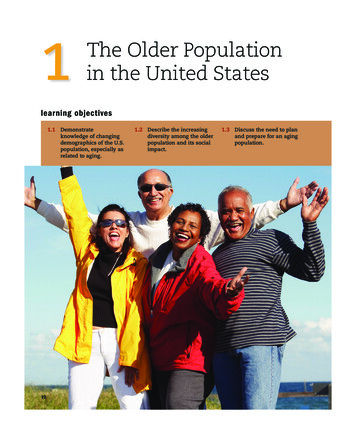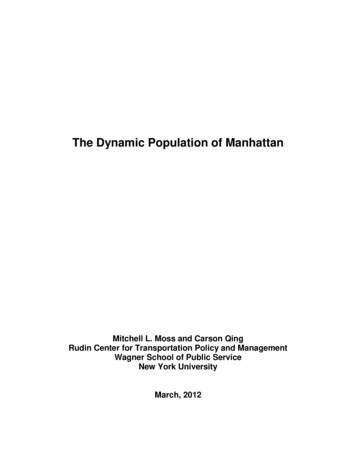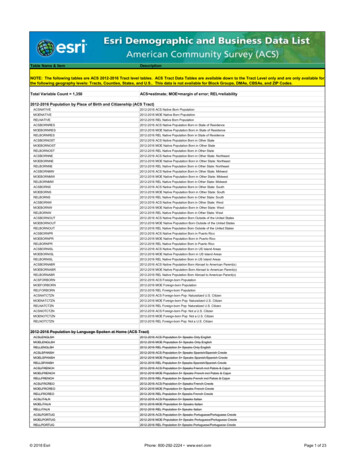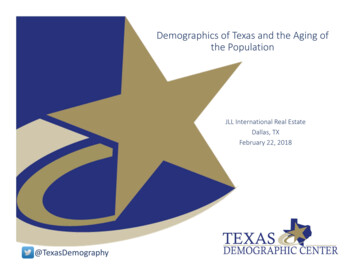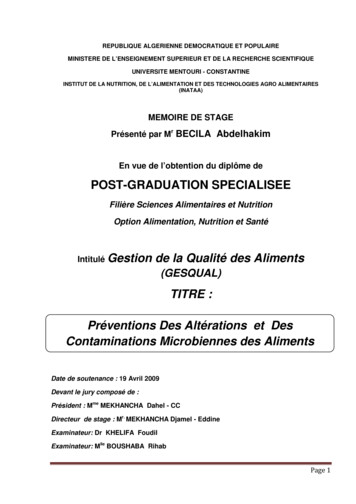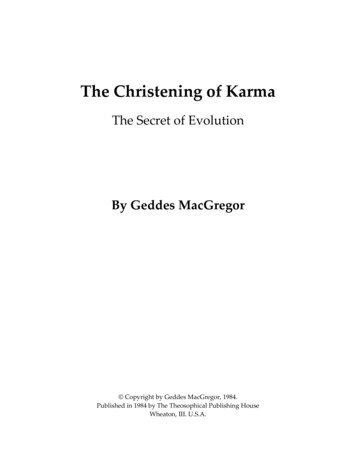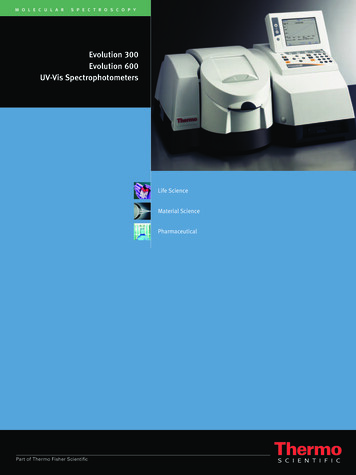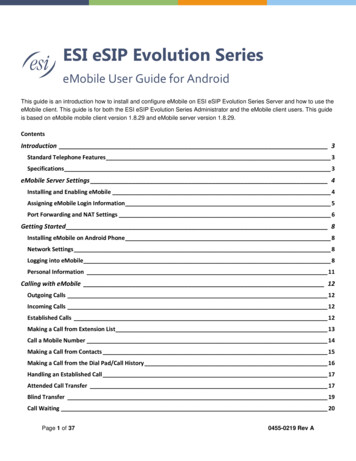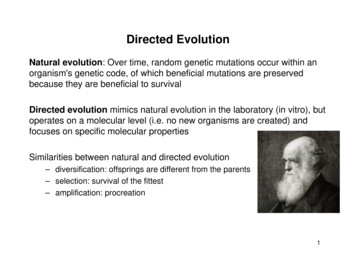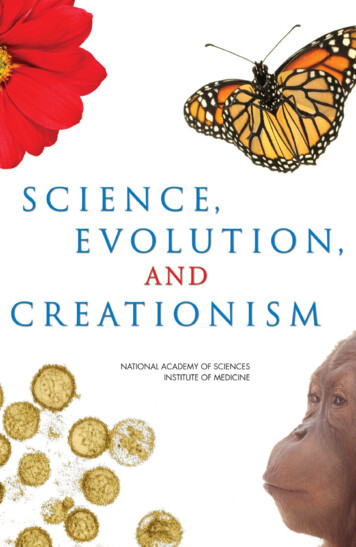
Transcription
Evolution basics/reviewReview of evolutionAAAAAAA population witha novel mutationa mutationcreatesa newalleleAAAAAAAAAAAAAAAn initialmonomorphicpopulationAaAAMutant dies withoutpassing on themutant "a" geneMutant passes on themutant "a" gene tosome descendentsAAThis can happeneven if the allele isbeneficial oradvantageous(due to stochasticityor chance).AaAAAaAAAaA population witha polymorphismThis can happen evenif the allele providesno benefit oradvantage toindividuals (due tostochasticity/chance).
Evolution basics/reviewAAAaaaAllele "a" is additive or codominantAAAaHeterozygotes haveintermediate phenotypesaaAllele "a" is DominantAAAllele "a" is recessiveHeterozygotes have samephenotype as "aa" homozygotesAaaaHeterozygotes have samephenotype as "AA" homozygotesNOTE: This is NOT the same as advantageous or deleterious
Evolution basics/reviewAAaaAllele "a" is advantageousIf individuals with horns have highersurvival or reproduction thanhornless, the horn is advantageousand so is the allele that makes it.Allele "a" is deleteriousIf individuals with horns have lowersurvival or reproduction thanhornless, the horn is deleteriousand so is the allele that makes it.Allele "a" is neutralIf individuals with horns have thesame survival and reproduction ashornless, the horn is neutraland so is the allele that makes it.NOTE: This is NOT the same as dominant, additive or recessive.
Evolution basics/reviewAAaaAllele "a" is advantageousThey can fight predators.Females prefer it.Allele "a" is deleteriousNo predators and it costs energy to grow.Females don't like it.Allele "a" is neutralNo predators and it has negligible cost.Females don't care about it.The fitness of an allele can depend on the environment,many predators or none for example.
Evolution basics/reviewAAEffect on fitness(Determined byenvironment)aaPhenotype of heterozygotes(Determined by development)"a" Recessive"a" Additive"a" Dominant"a" Advantageousselectionto fixweakselectionto fixstrongselectionto fixstrong"a" Deleteriousselectionto removeweakselectionto removestrongselectionto removestrong"a" NeutralNo selectionNo selectionNo selection
Evolution basics/reviewAAEffect on fitness(Determined byenvironment)aaPhenotype of heterozygotes(Determined by development)"a" Recessive"a" Additive"a" Dominant"a" Advantageousselectionto fixweakselectionto fixstrongselectionto fixstrong"a" Deleteriousselectionto removeweakselectionto removestrongselectionto removestrong"a" NeutralNo selectionNo selectionNo selectionThis is why so many geneticdiseases are recessive
Evolution basics/reviewA population witha novel mutationThe initialmonomorphic populationAAAAAAAAAAAAAAAAAaAAAAAAPolymorphism can still be lost,especially if allele is neutral ordeleterious. Loss of polymorphismis also faster in small populations.Minor polymorphism:frequency less than 5%AAMajor polymorphism:frequency more than 5%AaAAAaAAAaA population witha polymorphism
Evolution basics/reviewA population witha novel mutationThe initialmonomorphic populationAAAAAAAAAAAAAAAAAaAAAAAAPolymorphism can still be lost,especially if allele is neutral ordeleterious. Loss of polymorphismis also faster in small populations.Mutant increases infrequency and fixesin populationAAFixation:The process thatleads to an allelebecoming monomorphic. Suchalleles are said"to fix" over time.AaaaAAAaAAaaaaAaA population witha polymorphismaaaaaaA monomorphic populationwith a new adaptation
Evolution basics/reviewAAaaThe fate of a novel mutation:- Can be lost.- Can increase in frequency, become a polymorphism.- Can increase even more to fixation and become an adaptation.These outcomes can be driven by selection due to the fitnessof the allele or trait.These outcomes are also influenced by randomness, genetic drift.Fitness: average contribution to the gene pool of the next generationmade by a typical individual with the genotype or phenotype.Genetic drift: changes in allele or trait frequencydue to stochastic (random) effects.Since fitness is a statistical concept, genetic driftcan cause frequencies to change in oppositionto that expected from the fitness.
Evolution basics/reviewPopulation genetics: study of changes in allele frequenciesAAAaaaf(AA) #AA / totalf(Aa) #Aa / totalf(aa) #aa / totalIf p f(A), q f(a) Then p q 1 and f(AA) p2, f(Aa) 2pq, f(aa) q2
Evolution basics/reviewPopulation genetics: study of changes in allele frequenciesIf p f(A), q f(a)Then p q 1AAf(AA) p2f(Aa) 2pqf(aa) q2AAAAaaa% p% qAaAAAapqp2% pAa% qaaaAaaapqq2
Evolution basics/reviewPopulation genetics: study of changes in allele frequenciesAAAaaaf(AA) #AA / totalf(Aa) #Aa / totalf(aa) #aa / totalIf p f(A), q f(a) Then p q 1 and f(AA) p2, f(Aa) 2pq, f(aa) q2Hardy-Weinberg equilibrium, a state at which the allele frequencies don'tchange, happens when 5 conditions (math. assumptions) are met:(1) No selection(2) No mutation(3) No migration(4) No stochasticity (infinite pop. size)(5) Random matingHardyp and q stay the same and so do genotype frequenciesWeinberg
Evolution basics/review(1) No selection(2) No mutation(3) No migration(4) No stochasticity (infinite pop. size)(5) Random matingWhat if there is selection?For fitnesses: w(AA), w(Aa), w(aa)𝑝𝑞 𝑝 𝑝 𝑤 𝐴𝐴 𝑤(𝐴𝑎) 𝑞 𝑤 𝐴𝑎 𝑤(𝑎𝑎)𝑤1.0A: Add. & Adv.A: Rec. & Adv.A: Dom. & Adv.0timeRate of change fastest at intermediate allele frequencies (most variation)Fisher's fundamental theorem of natural seletion: the rate of evolution isproportional to genetic variance.
Evolution basics/review(1) No selection(2) No mutation(3) No migration(4) No stochasticity (infinite pop. size)(5) Random matingWhat if there is selection?Selection for alleles at one locus can increase the frequency ofnearby alleles, even if they are not advantageous themselves.Such an effect is called genetic hitchhiking
Evolution basics/reviewHitchhikingnew advantageousmutant createdSelection increasesthe frequencyRecombination canoccur sometimes
Evolution basics/review(1) No selection(2) No mutation(3) No migration(4) No stochasticity (infinite pop. size)(5) Random matingWhat if there is selection?Selection for alleles at one locuscan increase the frequency ofnearby alleles, even if they arenot advantageous themselves.Such an effect is calledgenetic hitchhikingThis has 2 effects:- Less genetic variation near selectedregions until mutation creates new variation.- Linkage disequilibrium (non-random association)between selected alleles and nearby neutralalleles.
Evolution basics/review(1) No selection(2) No mutation(3) No migration(4) No stochasticity (infinite pop. size)(5) Random matingFor fitnesses:w(AA) 1w(Aa) 1-hsw(aa) 1-sselection mutation0qWhat if there is mutation?𝜇𝑞 ℎ𝑠𝑞 𝜇𝑠Dominantalleles-6m 10 ,s 0.1,h 1q 0.00001Recessivealleles-6m 10 , s 0.1,h 0q 0.0032q2 f(aa) 1x10-92pq f(Aa) 0.00002q2 f(aa) 0.0000120 sick per million10 sick per million1.0Mutation-selection balance: deleterious alleles persist in populations at anequilibrium level determined by mutation rate and strength of selection.Genetic load: The reduction in mean fitness due to segregating deleteriousalleles, L 2m or m, depends on mutation rate (m), not fitness effect (s).
Evolution basics/review(1) No selection(2) No mutation(3) No migration(4) No stochasticity (infinite pop. size)(5) Random matingislandmainlandmWhat if there is migration?mmmOver time, even for very low migration rates (m), migrationcauses the alleles frequencies to become identical.Migration destroys diversity and variation in frequencies.Similar allele frequencies indicates at least minimal migration.
Evolution basics/review(1) No selection(2) No mutation(3) No migration(4) No stochasticity (infinite pop. size)(5) Random matingWhat about realistic pop sizes?In populations with finite number of individuals, relatives are forced to mate.Inbreeding:Increases loss of genetic diversity.Reduces the frequency of heterozygotes.Increases frequency of homozygotes, exposing recessivealleles to selection (inbreeding depression)Inbreeding depression: thereduction in mean fitness dueto increased frequency ofindividuals homozygous fordeleterious recessive alleles
Evolution basics/review(1) No selection(2) No mutation(3) No migration(4) No stochasticity (infinite pop. size)(5) Random matingWhat about realistic pop sizes?Genetic drift: changes in allele frequency and even fixation for neutral allelesChance events can change allele frequencies: bigger changes in smallerpopulations (sampling error) so selection is weaker in smaller populations.1.01.000timetimesmall pop.Large pop.
Evolution basics/review(1) No selection(2) No mutation(3) No migration(4) No stochasticity (infinite pop. size)(5) Random matingWhat about realistic pop sizes?Genetic drift: changes in allele frequency and even fixation for neutral allelesChance events can change allele frequencies, bigger changes in smallerpopulations (sampling error), selection is weaker in smaller populations.For fitnesses:w(AA) 1w(Aa) 1 hsw(aa) 1 sFor fitnesses:w(AA) 1w(Aa) 1 hsw(aa) 1 sIf s 0, Prob. fix. 1/2NFixation takes 4N gensIf s 0, Prob fix. 2hsFixation takes (4/s)[Ln(Ns) 1] gensFixation not guaranteed,is actually rareeven for adv. alleles
Evolution basics/review(1) No selection(2) No mutation(3) No migration(4) No stochasticity (infinite pop. size)(5) Random matingIf s 0, Prob. 1/2NIf s 0, Prob fix. 2hsWhat about realistic pop sizes?When is selection more important than drift?Assuming h 1/2, it is when s 1/2NSelection is weak in small populations- Some del. alleles can fix- Fewer Adv. alleles fixSelection is stronger in big populations - Very few del. alleles can fix- More Adv. alleles fixsLarge N, selection not effective, s 1/2NSmall N, selection not effective, s 1/2N
Evolution basics/review(1) No selection(2) No mutation(3) No migration(4) No stochasticity (infinite pop. size)(5) Random matingWhat about non-random mating?At Hardy-Weinberg EquilibriumIf p f(A), q f(a), then p q 1f(AA) p2f(Aa) 2pqf(aa) q2p and q stay the same and sodo genotype frequenciesIf Non-random matingIf p f(A), q f(a), then p q 1f(AA) p2f(Aa) 2pqf(aa) q2p and q stay the same butgenotype frequencies can changeAAAaaaf(AA) #AA / totalf(Aa) #Aa / totalf(aa) #aa / total
Evolution basics/review(1) No selection(2) No mutation(3) No migration(4) No stochasticity (infinite pop. size)(5) Random matingPositive assortative matingSimilar genotypes matef(AA) p2f(Aa) 2pqf(aa) q2What about non-random mating?Negative assortative matingSimilar genotypes avoid matingf(AA) p2f(Aa) 2pqf(aa) q2Fewer heterozygotesFewer homozygotesThe New Yorker Magazine, aaaa
Evolution basics/review(1) No selection(2) No mutation(3) No migration(4) No stochasticity (infinite pop. size)(5) Random matingWhat about non-random mating?Effective population size (Ne):The size the population acts like in terms of maintaining diversity(vs drift).Is almost always lower than the actual population size.Factors that cause Ne N:- Selection- Two genders- Positive assortative mating- Inbreeding (relatives mate)- Geographic ranges (nearby mate)- Fluctuating population size (Ne mean N)
Evolution basics/review(1) SelectionMore powerful in populations with more variationChanges allele frequencies and fixes allelesReduces diversity(2) MutationCreates variation, fuel for selectionMutation:selection balance creates a genetic load (I.E., diseases)(3) MigrationHomogenizes populations, destroys diversity(4) Stochasticity (infinite pop. size)Weakens power of selectionMore important in smaller populations(5) Non-random matingEliminates heterozygotes if positive assortative mating (inbreeding)Increases heterozygotes if negative assortative matingCauses Ne N
Evolution basics/reviewThe factors that caused the mutation (UVradiation, free radical, etc.) did not occurbecause the population wanted to aaaaa
Evolution basics/reviewNOTE: none of the individuals evolved. The alleles in the initial population werereplaced, generation by generation, by a new ones.We say that the population evolved, but even that is technically incorrect because thefinal population is completely different individuals - there is no single aAaaaaaaa
Evolution basics/reviewWARNING: common misconceptions about evolutionAAAAAAAAAAAAAAAAAaAAAAAAAAIndividuals evolve- No, populations do (and even this thinking isn't perfect).aaAAAAaaaaAaAaAaaaaaaaMutations happen in order to provide needed adaptations.- Mutations occur, sometimes they lead to evolution/adaptation.How often mutations occur and how they changetraits is unrelated to utilitySelection favors traits because they improve populations- When this occurs it is a side-effect of selection on individuals,sometimes evolution actually make populations worse.Evolution always finds the optimal form- Since selection is short-sighted, improvements are usually made,but lack of foresight means better solutions may be missed.Evolution is perfect/unstoppable- Ask the dinosaurs that question.
Bio 312: EvolutionFocus PhenotypeHow we study evolution/scienceHistory of the fieldContexts/tradeoffs that determine fitnessMath of allele freq. changes (population genetics)Human evolutionBio 472/572: Molecular EvolutionFocus GenotypeGenotype:phenotype mapTypes of mutations and genotype changesDescription of techniques to determine genotypes (GWAS, microarrays)Applications of these techniquesExamples including human disease and medicineBio 412/512: Advanced EvolutionFocus NoneIn depth seminar/discussions about specialized topics
Mutation-selection balance: deleterious alleles persist in populations at an equilibrium level determined by mutation rate and strength of selection. Genetic load: The reduction in mean fitness due to segregating deleterious alleles, L 2m or m, depends on mutation rate (m), not fitness effect (s). 0 q 1.0 selection mutation Dominant alleles


